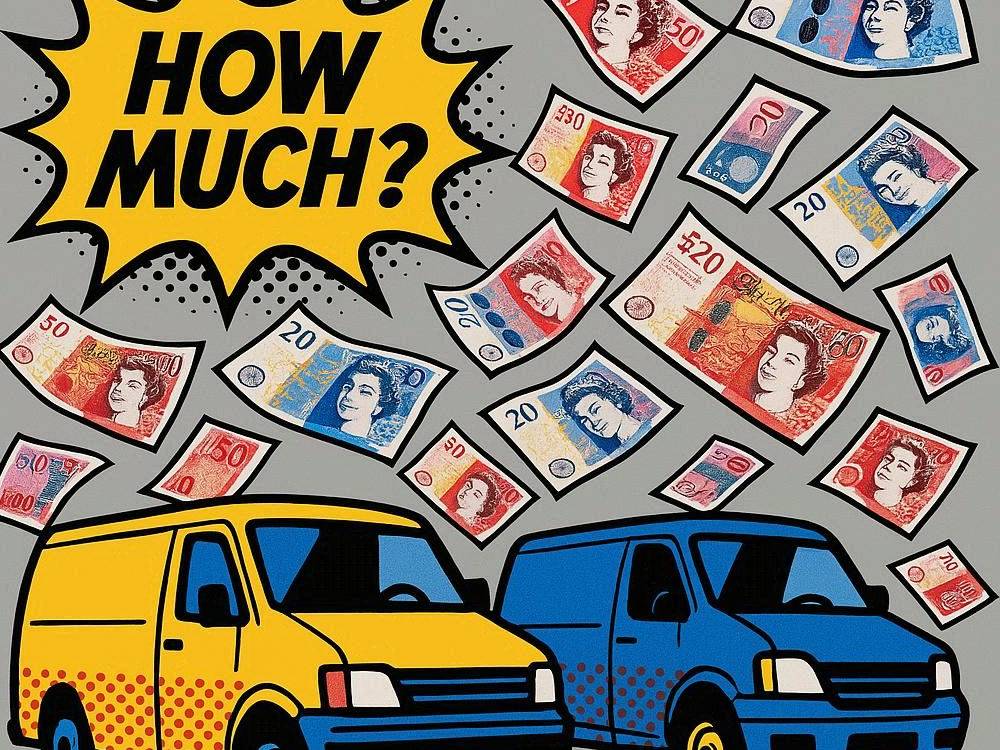Introduction
Finding out how much van insurance should really cost isn’t as straightforward as it sounds.
Prices can vary dramatically — sometimes by hundreds of pounds — depending on who you are, what you drive, and how you use it.
The average comprehensive van insurance policy in the UK sits around £721.48 per year, but many drivers pay far less.
So how can you make sure you’re one of them?
Let’s find out.
Understanding The Real Cost Of Van Insurance
Van insurance costs are never one-size-fits-all.
Every driver’s quote tells a story — about their van, their habits, and their risk level.
That’s why comparing your premium to someone else’s rarely makes sense.
Still, let’s put things into perspective.
The average annual cost for comprehensive van insurance in the UK is around £721.48, according to industry data.
But here’s the catch — this number hides huge variation.
Some experienced drivers with clean records pay closer to £400.
Others, particularly young or high-risk drivers, can face premiums north of £1,000.
So What Drives Those Van Insurance Differences?
Several key factors combine to set your price:
Your age, postcode, van type, mileage, use, and driving history all play their part.
For example, a driver in rural Wales with a small Ford Transit used only for weekend hobbies will likely pay far less than a London-based courier putting in 200 miles a day.
That’s why understanding these variables is the first step to finding Cheap Van Insurance that fits your needs.
“The more accurately you represent your van’s use and details, the more realistic — and often lower — your quote will be.”
Need proof?
Check your current cover against your actual use with our guide:
Are you driving a car or a van? Check your insurance policy.
It might surprise you how many drivers are unknowingly misclassified — and overpaying as a result.
Key Factors That Shape Your Van Insurance Premium
Let’s break it down further.
Here’s what really influences your van insurance cost — and how to use that knowledge to your advantage.
The Type Of Van Insurance Cover You Choose
Not all policies are created equal.
Comprehensive cover protects you, your van, and other vehicles — even if the accident’s your fault.
Third-party, fire, and theft offers less protection, but can be cheaper upfront.
However, cheaper doesn’t always mean smarter.
Often, comprehensive cover ends up saving you money long-term because of wider claim protection.
That’s why finding cheap van insurance should always mean “smart” rather than “bare minimum.”
How You Use Your Van
Business or personal?
That’s one of the first questions insurers will ask — and for good reason.
A van used daily for deliveries or trade work faces a higher risk than one used occasionally for personal errands.
So yes, business van insurance often costs more.
But accurate classification prevents claim rejection — which could save you thousands.
For example, if your van’s used for contract jobs, you’ll likely fall under “carriage of goods for hire or reward.”
This falls into a higher-risk category than “social, domestic, and pleasure.”
Learn why compliance matters in our guide on
Why proper vehicle compliance is crucial for road safety.
Where You Live And Park
It might seem unfair, but your postcode heavily influences your premium.
Urban areas with higher theft rates generally mean higher costs.
If you park on-street overnight in London, expect a bigger bill than someone with a private driveway in Devon.
Insurers use postcode data to assess local claims history — it’s all about risk prediction.
So, secure parking and low-crime areas?
They make a huge difference to your quote.
The Van Itself
Weight, engine size, and even colour can influence your cost.
High-performance models or modified vans usually fall into pricier insurance groups.
But the good news?
You can use telematics and smart devices to counteract that.
Installing a black box or GPS tracker can lower your perceived risk and reduce premiums by up to 25%.
Find out more in our article:
How telematics devices can save you money on van insurance.
Your Driving Record
No-claims bonuses are pure gold in the world of van insurance.
The more claim-free years you rack up, the better your discount.
Even minor speeding points can push up your premium, so keeping a clean record matters.
Here’s the deal — insurers love predictability.
And a driver with five years of safe driving history looks like a much safer bet than someone who just got their licence.
But wait — there’s more to the story.
In the next section, we’ll explore how to find Cheap Van Insurance UK without compromising on cover or quality.
Because saving money shouldn’t mean sacrificing peace of mind.
How To Find Cheap Van Insurance In The UK
Now that you know what affects your premium, let’s talk about how to actually bring that number down.
Because the truth is — most van drivers are overpaying without even realising it.
So, what can you do right now to cut costs without cutting corners?
Let’s dive in.
Compare Van Insurance Like A Pro
It sounds obvious, but how you compare policies matters just as much as where you compare them.
Many drivers go straight to comparison sites, tick a few boxes, and pick the cheapest quote they see.
But here’s the problem — not all policies are built equally.
Some come with hidden fees, higher excesses, or missing cover for tools and equipment.
A better move?
Use a specialist broker like Cheap Van Insurance UK that compares tailored policies across trusted insurers.
You’ll often find deals that never appear on big aggregator sites — and that can save serious cash.
Boost Your No-Claims Bonus
Each year you drive claim-free, your no-claims discount grows — and it’s one of the most powerful cost-cutting tools you have.
Protect it wherever possible.
It’s worth paying a little extra to keep your discount intact after a minor claim.
Because one accident shouldn’t wipe away years of safe driving benefits.
Choose The Right Excess
Another trick to find cheap van insurance is to tweak your excess.
By increasing your voluntary excess — the amount you pay if you make a claim — you can lower your premium.
But here’s the catch:
Don’t set it too high.
If it’s unaffordable when you need it, you’ll regret the short-term saving.
Strike the balance between risk and reward, and you’ll find your sweet spot.
Improve Your Van’s Security
Every lock, tracker, and immobiliser helps.
Adding a Thatcham-approved alarm or steering lock can make your van far less attractive to thieves — and insurers know it.
Want a quick win?
A dash cam or telematics box can instantly make you a lower-risk driver in the eyes of insurers.
That means more savings, month after month.
Pay Annually, Not Monthly
Paying monthly might seem convenient, but you’ll likely pay more overall.
Why?
Because insurers add interest to instalments.
If you can afford to, pay your full premium upfront — it’s one of the simplest ways to save.
When Paying More Actually Saves You Money
Here’s something most drivers overlook.
Sometimes, the cheapest policy ends up being the most expensive one in the long run.
Confused?
Let me explain.
Choosing very cheap van insurance might mean losing out on extras like breakdown cover or replacement vehicle hire.
If your van’s off the road for days after an accident, those extras suddenly look priceless.
So while price matters, protection matters more.
That’s why the smartest move isn’t to chase the cheapest quote — it’s to find value.
Comprehensive cover might cost slightly more upfront but can save you thousands later if you’re involved in a claim.
It also provides peace of mind — knowing your van, your tools, and your livelihood are protected.
For more insight, read our detailed guide:
Top van insurance mistakes that could be costing you money.
Conclusion
What’s the Right Price for You?
So, how much should van insurance really cost?
The honest answer — it depends entirely on you.
Your age, your van, your postcode, your driving history, and your cover type all shape your premium.
But here’s the good news.
By understanding how insurers calculate costs and making a few smart tweaks, you can find cheap van insurance that doesn’t cut corners on cover.
Because at the end of the day, peace of mind shouldn’t come at a premium.
Keep Reading
- 10 Simple Hacks to Instantly Lower Your Van Insurance and Save Big
- Van Insurance: What Counts as a Modification?
- Van Insurance Mistakes
Want to see how much you could save today?
Head over to CheapVanInsurance.co.uk and find your best deal — fast, simple, and built around you.






